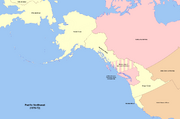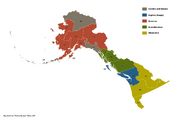No edit summary |
|||
| Line 1: | Line 1: | ||
| + | <!-- |
||
| ⚫ | |||
| + | |||
| + | |||
| + | |||
| + | |||
| + | EOGUY, PLEASE DON'T CORRECT THIS ARTICLE. THANK YOU. |
||
| + | |||
| + | |||
| + | |||
| + | |||
| ⚫ | |||
{{clear}} |
{{clear}} |
||
[[File:Flag of Cascadia.svg|thumb|right|"The Doug" is the ''de facto'' flag used by English Alaskans.]] |
[[File:Flag of Cascadia.svg|thumb|right|"The Doug" is the ''de facto'' flag used by English Alaskans.]] |
||
Revision as of 23:23, 30 April 2018
| The following Russian America page is under construction.
Please do not edit or alter this article in any way while this template is active. All unauthorized edits may be reverted on the admin's discretion. Propose any changes to the talk page. |

"The Doug" is the de facto flag used by English Alaskans.
English Alaskans (Russian: Английские Аляскинцы, Angliyskiye Alyaskintsy), colloquially referred to as Dougs (Даги, Dagi), are citizens of the Alaskan Democratic Federative Republic who can trace their ancestry back to, or were born in the United Kingdom (more specifically England). Most English Alaskans can trace their ancestry back to the original British settlers of the Pacific Northwest during the 18th and 19th Centuries, with English Alaskans being the majority in the governorates of the Queen Charlotte Islands and Vancouver Island, as well as the plurality in Columbia.
Since the 1920s, the term "Doug" has become a nickname for Alaskans of English descent, comparable to the use of Kiwi and Yankee to describe people from New Zealand and the United States (respectively). The name is derived from the Doug (the national flag of the short-lived Commonwealth of Columbia), which in turn gained its name from the silhouette of a Douglass fir on the flag. While often used to describe all Anglo-American Alaskans, the term is generally only used to describe those who are descendant of the original British settlers to the region.
History
Colonial Period
The British became active on the Pacific coast of North America since the 18th century as part of the lucrative fur trade. The area of modern day southern Alaska was also claimed by the Americans and the Spanish, but following the Russo-Spanish War in the 1820s, the Russian Empire emerged as the main rival to the region. Following the Treaty of Saint Petersburg in 1827, the Columbia River would act as the boundary between British Columbia and Russian Oregon, with the disputed New Caledonia acting as a unorganized buffer from the northern Russian territories.

A map showing the British colonial claims (pink) in the Pacific Northwest.
Throughout the 19th century, the population of British Columbia began to rise due to the fur trade, but much of it was focused on Vancouver Island and northern bank of the Columbia River. Following Russia's defeat in the Crimean War, the Queen Charlotte Islands became fully British (due in part to the discovery of gold on the islands). Despite an active population, the cost of the colony became too great, ultimately ending British rule with the Columbia Purchase of 1872. The period between 1872 up until the early 1880s was dominated by what would become known as the Doug Diaspora, in which the British colonists relocated outside the Russian Empire (mostly to Australia, Borealia, and the United States). To prevent tensions in the area, Russia agreed to lax their previous efforts to Russify and displacement of the English colonists, slowing down the diaspora. Cossacks were originally used as tax collectors from Doug minorities but they were soon replaced by civilian administrative officials.
Despite the initial assurances by the Russian Empire, indirect moves to Russify the population took place throughout the remainder of the 19th century. Among the programs included the settlement of Russian Protestants and other non-Russian subjects into the area (including Finns, Germans, and Scandinavians). Another program, which has mostly fallen out of use, was the adoption of the Cyrillic alphabet for the English language. English Alaskans were and are remarkable as one of the only large groups of English expats to live in a country where English is not the dominant culture. Increasingly English Alaskans felt that now resided in an Asiatic country, this was part of a traditional European prejudice to view Russia as an Asian rather than European country.
20th Century
The situation for the English changed in 1917 and the collapse of the Russian Empire. As part of a nationalistic rise which began around the early 1910s, the former British colonies declared independence as the Commonwealth of Columbia. Under the new government, move to derussify the population were enacted, though met with opposition. Following continued internally conflicts and ultimately economic troubles, Columbia officially rejoined with its neighbors. Despite its failures, the time of independence helped to rejuvenate the English heritage of the region, leading to the popularity of "Doug" and "New Albion" for the people and region, as well as a resurgence of the English language and peoples to the region.
The English resurgence came at a cost to most other cultures in the region. All religions outside of the Protestant denomination faced governmental restrictions while Alaska's Buddhist minorities were forcibly expelled. Native Russian speakers were forced to speak English or also face expulsion. Cossacks fled to the edges of Columbian territories to fight a guerrilla war against rampaging militias. Racial minorities such as the Alaskan Indians faced segregation and race riots. The negative legacy of English Racism would be remembered long after the reunification of Alaska.
Throughout the 1920's and 1930's Columbia styled as New Albion desperately looked for recognition from the large English speaking countries. Overall English citizens abroad were sympathetic to the Colombian cause but liberals were disappointed by Colombian social policies. Both Borelia and the United States were interested in intervening for the sake of containing Communism in the Alaskan Socialist Republic
Demographics

Map showing the largest ancestral groups of Alaska by governorate (English Alaskan governorates are shown in blue).
English Alaskans are spread out across Alaska, but the majority are centered in the south-central governorates. Those of English descent make up the majority in Vancouver Island (74%) and the Queen Charlotte Islands (61%), with an English plurality in Columbia (38%). Along with New Caledonia, these governorate form the region of New Albion.
Much of the English Alaskan population speak Russian as their first language, but first English-speakers have large say in the Queen Charlotte Islands and Vancouver Island (where about 30-50% of residents place English as their first language). English is the most fluent language of Alaska (with over 60% of Alaskans having basic knowledge of English).
Terminology
The name Doug has become a popular nickname to describe all English Alaskans. Though much like Yankee, the term has varying definitions based on its regional use. Internationally (especially within Borealia and the United States), a Doug can generally refer to any non-Russian English-speaking Alaskan. Within Alaska, a Doug (known as Даги [Dagi]) mostly refers to those living in New Albion. Among the Doug themselves, the term strictly refers to those descended from the original British (but mostly English) settlers of British Columbia, leaving out Americans and later English settlers (regarded similarly to Cajuns of Louisiana not referring to all French Louisianans).
| |||||
